

Session 3 - ET 700 Podcasting. Podcast Generator - Open Source Podcast Publishing Solution. Posterous. Posterous - API to posterous.com use Posterous; $posterous = Posterous->new($user, $pass, $site_id); $posterous->account_info; $posterous->add_post( title => "hello posterous", body => "Post through Posterous.pm" ); Posterous.pm just implement interface to posterous.com in Perl new($user_mail, $pass, $site_id) constructor, $user_mail and $pass are required.
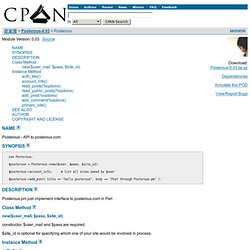
$site_id is optional for specifying which one of your site would be involved in process. auth_key() always return Base64 encoded "$user_mail:$pass" for Basic HTTP Authentication account_info() GET /api/getsites, return a list of all sites owned by specified user read_posts(%options) GET /api/readposts, return a list of list. Available %options key include site_id, hostname, num_posts, page, tag. read_public_posts(%options) GET /api/readposts, without Basci HTTP Authentication. Since, site_id or hostname should be specified in %options. Available %options key is the same as read_posts() Welcome@CMSQlite - SQLite Content Management System. Latest Version: 1.3.2 -> download Security Pacth Version: 1.3.1 -> 1.3.2 -> download Welcome to CMSQLite, the CMS based on SQLite.
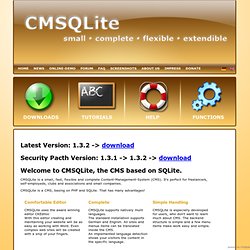
CMSQLite is a small, fast, flexible and complete Content-Management-System (CMS). It's perfect for freelancers, self-employeds, clubs and associations and small companies. CMSQLite is a CMS, basing on PHP and SQLite. The advantages in the overview: The advantages for Users: simple handling without any knickknacksIntegrated multi language supportCreate and extend your menus and your contentMaintain your files (photos, PDF, etc.) with the integrated media adminsitrationIntegrated text editor CKEditor (version 3.0.1) Advantages for Developers:
Flowplayer - Flash Video Player for the Web. Open Source CMS Demos & Information. » TangoCMS, Open Source PHP CMS. End_user_documentation [Wolf CMS Wiki] RazorCMS » Open source databaseless PHP flat file content management system, for web servers without a database, supporting CMS extension add-ons and themes. The zen of blogging. Home :: plugins Blosxom Plugin Registry Blosxom is about infinitely extensible via a plugin architecture.
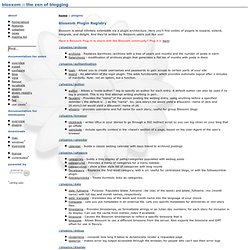
Here you'll find oodles of plugins to expand, extend, integrate, and delight. And they're written by Blosxom users just like you! Have a Blosxom Plug-in to share with the Blosxom community? /plugins/archives archives - Replaces $archives::archives with a tree of years and months and the number of posts in each. flatarchives - modification of archives plugin that generates a flat list of months with posts in them /plugins/authentication login - Allows you to create usernames and passwords to gain access to certain parts of your site login2 - An alteration of the login plugin.
Create A Network. Languages: বাংলা • English • Français • 日本語 • Português do Brasil • Português • Русский • ไทย • 中文(简体) • Español • (Add your language) As of WordPress 3.0, you have the ability to create a network of sites by using the multisite feature.
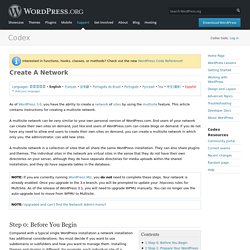
This article contains instructions for creating a multisite network. A multisite network can be very similar to your own personal version of WordPress.com. End users of your network can create their own sites on demand, just like end users of WordPress.com can create blogs on demand. If you do not have any need to allow end users to create their own sites on demand, you can create a multisite network in which only you, the administrator, can add new sites. A multisite network is a collection of sites that all share the same WordPress installation.
NOTE: If you are currently running WordPress MU, you do not need to complete these steps. Step 0: Before You Begin. Tutorial. Dancer::Tutorial - An example to get you dancing Dancer is a "micro" web framework which is modeled after a Ruby framework called Sinatra that constructs web applications by building a list of HTTP verbs, URLs (called routes) and methods to handle that type of traffic to that specific URL. use Dancer; get '/' => sub { return 'Hello World!
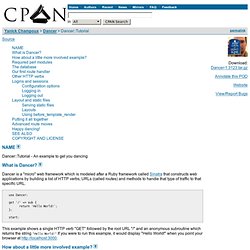
'; }; start; This example shows a single HTTP verb "GET" followed by the root URL "/" and an anonymous subroutine which returns the string "Hello World! " If you were to run this example, it would display "Hello World! " That's the reason I wrote this tutorial. Using the Flaskr sample application as my inspiration (OK, shamelessly plagiarised) I translated that application to the Dancer framework so I could better understand how Dancer worked. So "Dancr" was born. Dancr is a simple "micro" blog which uses the SQLite database engine for simplicity's sake. Obviously you need Dancer. Cpan Dancer Template File::Slurp DBD::SQLite Nothing too fancy in here, I hope. The Onion Stand: Tweetylicious - a Twitter-like microblogging app in just one file!